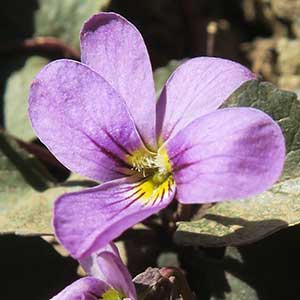Viola lobata
Viola flettii
moose horn violet, pine violet, yellow wood violet
Flett's violet, Olympic violet, rock violet
1–3, erect, leafless proximally, leafy distally, glabrous or puberulent, from subligneous rhizome.
1–3, ascending to erect, mostly glabrous, on caudex from fleshy rhizome.
basal and cauline;
basal: 0–2, unlobed or palmately 3–11-lobed;
stipules ovate to lanceolate, margins ± entire or serrate, apex acute;
petiole 5–27 cm, glabrous or puberulent;
blade sometimes glaucous, deltate to reniform, 3.5–8.5 × 4.5–13.5 cm, base cordate, truncate, or attenuate, margins on unlobed leaves coarsely dentate-serrate, margins on lobed leaves usually entire, sometimes few-toothed, ciliate (sometimes only proximal 1/2) or eciliate, apex acute to obtuse, mucronulate, surfaces glabrous or puberulent;
cauline similar to basal except: distal on naked stems, unlobed and divided leaves can occur on same plant, if divided, palmately 3–12-lobed;
stipules sometimes large and ± leaflike, margins entire, lacerate, or laciniate, sometimes with gland-tipped projections, apex acute to acuminate;
petiole 0.2–8.8 cm;
blade reniform to reniform-cordate, ± ovate, deltate, or rhombic, 1.5–5.5 × 1.4–10 cm, base cordate, subcordate, truncate, or attenuate, margins entire, crenate-serrate, or dentate, or coarsely lacerate to deeply serrate, often entire distally, ciliate or rarely eciliate, apex acute to obtuse, often long-tapered, mucronulate.
basal and cauline;
basal: 1–3;
stipules linear-lanceolate, margins entire or with glandular processes, apex acuminate;
petiole 1.5–9.7 cm, mostly glabrous;
blade purple-tinted and –veined, broadly reniform to ovate, 0.9–2.4 × 1.2–4 cm, base cordate, margins finely crenate-serrate, eciliate, apex acute to obtuse, surfaces glabrous or sparsely pubescent along veins adaxially;
cauline similar to basal except: stipules ovate to lanceolate, margins entire or shallowly laciniate;
petiole 0.7–5.9 cm, usually glabrous;
blade 0.8–2.1 × 1.2–3.1 cm.
2–13 cm, glabrous or pubescent.
1.8–7.1 cm, usually glabrous.
sepals lanceolate, margins ciliate or eciliate, auricles 0.1–1 mm;
petals deep lemon-yellow adaxially, usually upper 2 and sometimes lateral 2 brownish purple abaxially, lower 3 and sometimes upper 2 brownish purple-veined basally, lateral 2 bearded, lowest 8–19 mm, spur yellow to greenish, gibbous, 0.5–2 mm;
style head bearded; cleistogamous flowers axillary.
sepals lanceolate, margins eciliate, auricles 0.5–1.5 mm;
petals soft reddish violet on both surfaces, all with yellow area basally, lower 3 dark violet-veined, lateral 2 bearded, lowest with white around yellow area, 10–15 mm, spur yellow, gibbous, 0.5–2 mm;
style head bearded; cleistogamous flowers axillary.
ellipsoid-ovoid, 6–16 mm, glabrous.
± spherical, 5–9 mm, glabrous.
light brown, blotched or streaked with brown, shiny, 2.1–2.7 mm.
dark brown to brownish purple, 2.5–3 mm.
= 12.
Viola lobata
Viola flettii
Varieties 2 (2 in the flora).
V. B. Baird (1942) noted that Viola lobata was more closely related to V. tripartita than to any western Viola.
(Discussion copyrighted by Flora of North America; reprinted with permission.)
Viola flettii is endemic to the Olympic Mountains of northwestern Washington. C. S. McCreary (2005) noted that although morphologically and ecologically distinct, V. cuneata, V. flettii, and V. ocellata are closely related.
(Discussion copyrighted by Flora of North America; reprinted with permission.)
1. Cauline leaf blades usually deeply divided, seldom unlobed, reniform, ± ovate, or deltate, if divided, palmately 3–12-lobed, lobe margins usually entire. | var. lobata |
1. Cauline leaf blades unlobed, deltate to rhombic, ovate, or reniform-cordate, margins ± serrate, crenate-serrate, or dentate to deeply serrate or coarsely lacerate, often entire distally. | var. integrifolia |


